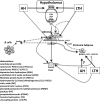Fetal endocrine and metabolic adaptations to hypoxia: the role of the hypothalamic-pituitary-adrenal axis
- PMID: 26173460
- PMCID: PMC4556885
- DOI: 10.1152/ajpendo.00126.2015
Fetal endocrine and metabolic adaptations to hypoxia: the role of the hypothalamic-pituitary-adrenal axis
Abstract
In utero, hypoxia is a significant yet common stress that perturbs homeostasis and can occur due to preeclampsia, preterm labor, maternal smoking, heart or lung disease, obesity, and high altitude. The fetus has the extraordinary capacity to respond to stress during development. This is mediated in part by the hypothalamic-pituitary-adrenal (HPA) axis and more recently explored changes in perirenal adipose tissue (PAT) in response to hypoxia. Obvious ethical considerations limit studies of the human fetus, and fetal studies in the rodent model are limited due to size considerations and major differences in developmental landmarks. The sheep is a common model that has been used extensively to study the effects of both acute and chronic hypoxia on fetal development. In response to high-altitude-induced, moderate long-term hypoxia (LTH), both the HPA axis and PAT adapt to preserve normal fetal growth and development while allowing for responses to acute stress. Although these adaptations appear beneficial during fetal development, they may become deleterious postnatally and into adulthood. The goal of this review is to examine the role of the HPA axis in the convergence of endocrine and metabolic adaptive responses to hypoxia in the fetus.
Keywords: adipose; cortisol; fetus; hypoxia.
Copyright © 2015 the American Physiological Society.
Figures

References
-
- No authors listed. ACOG technical bulletin. Pulmonary disease in pregnancy. Number 224—June 1996. American College of Obstetricians and Gynecologists. Int J Gynaecol Obstet 54: 187–196, 1996. - PubMed
-
- Adachi K, Umezaki H, Kaushal KM, Ducsay CA. Long-term hypoxia alters ovine fetal endocrine and physiological responses to hypotension. Am J Physiol Regul Integr Comp Physiol 287: R209–R217, 2004. - PubMed
-
- Adams MB, Phillips ID, Simonetta G, McMillen IC. Differential effects of increasing gestational age and placental restriction on tyrosine hydroxylase, phenylethanolamine N-methyltransferase, and proenkephalin A mRNA levels in the fetal sheep adrenal. J Neurochem 71: 394–401, 1998. - PubMed
-
- Ahima RS, Saper CB, Flier JS, Elmquist JK. Leptin regulation of neuroendocrine systems. Front Neuroendocrinol 21: 263–307, 2000. - PubMed
Publication types
MeSH terms
Grants and funding
LinkOut - more resources
Full Text Sources
Other Literature Sources
Medical

